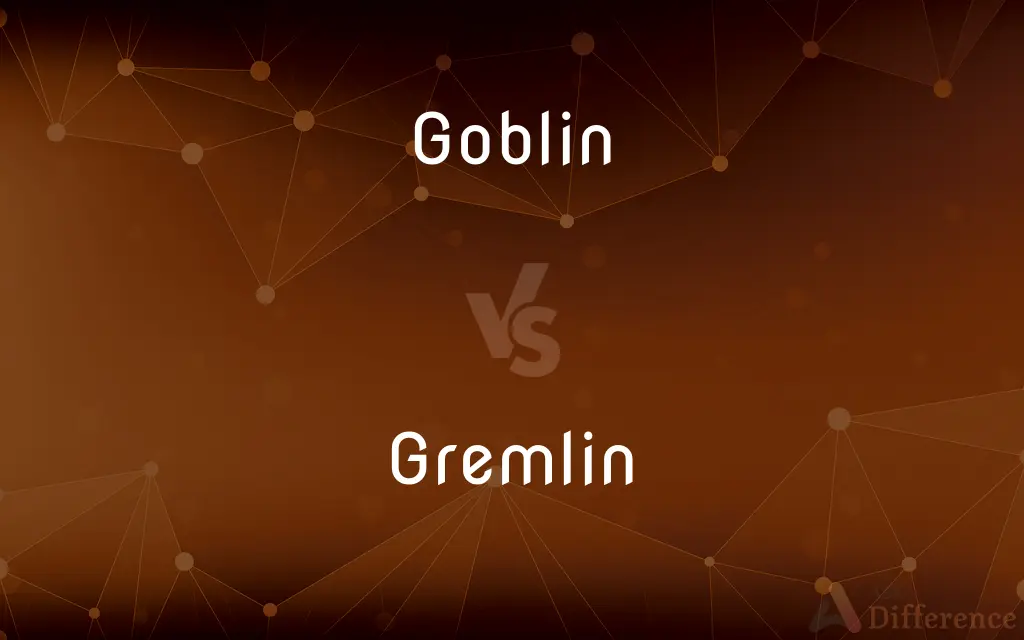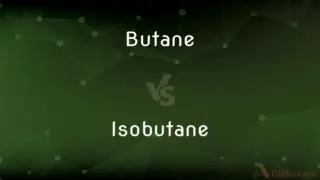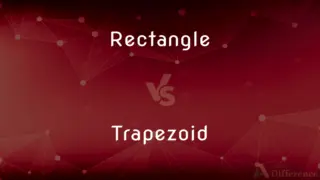Goblin vs. Gremlin — What's the Difference?
By Tayyaba Rehman — Updated on August 24, 2023
Goblin is a mythical creature often depicted as a mischievous, ugly dwarf, while a gremlin is a fictional creature known for causing malfunctions, especially in aircrafts.

Difference Between Goblin and Gremlin
Table of Contents
ADVERTISEMENT
Key Differences
Goblin, in folklore and mythology, is commonly visualized as a small, grotesque, often malicious creature. They're usually found in European tales and are akin to dwarves or elves, but with a more malevolent nature. On the other hand, gremlins are more modern in their conceptualization. These creatures became popular during World War II among British aviators who blamed unexplained mechanical failures on them.
Goblins, historically, have a variety of origins and characteristics based on the region and the tale. Some see them as harmless, while others view them as malevolent. Gremlins, though, have a more singular origin, with their mythology centered around mischief and sabotage, particularly of machines.
When we look at pop culture's portrayal, goblins often feature in fantasy settings. They might be depicted as cunning adversaries or simple, gold-loving creatures. Gremlins, after the 1980s film of the same name, are often associated with the idea of small, mischievous creatures that can replicate when exposed to water and have a chaotic nature.
Another distinction can be drawn from their typical habitats. Goblins, with their roots in folklore, are associated with natural settings such as forests, mountains, or caves. Gremlins, given their predilection for sabotaging machinery, are more associated with man-made environments like aircrafts or factories.
The physical appearance of these two creatures often varies. Goblins are typically depicted as green or brown-skinned with pointy ears, while gremlins can range from fuzzy and cute to reptilian and menacing, depending on their stage of mischief.
ADVERTISEMENT
Comparison Chart
Origin
European folklore
Modern tales, especially WWII aircraft lore
Nature
Ranges from harmless to malevolent
Mischievous and saboteur
Popular Setting
Fantasy, forests, caves
Modern, machinery, aircrafts
Typical Appearance
Ugly dwarf, green or brown-skinned
Varies; from fuzzy to reptilian
Relationship to Humans
Often adversarial, sometimes neutral
Mischief-maker, often causing malfunctions
Compare with Definitions
Goblin
A grotesque, often malicious dwarf-like creature from European folklore.
The goblin hid in the shadows, waiting to play its tricks.
Gremlin
A mischievous fictional being, popularized by WWII aviators and later films.
After the mishap, the engineer blamed a gremlin for the equipment failure.
Goblin
A mythical mischief-maker, often associated with hoarding treasures or gold.
The hero entered the cave to retrieve the gold stolen by the goblin.
Gremlin
A small, often endearing creature known to multiply when exposed to water.
He mistakenly poured water on the gremlin, leading to chaos.
Goblin
A creature of fantasy, often portrayed as an adversary in tales and games.
The adventurers prepared to battle the goblin army that guarded the fortress.
Gremlin
A creature believed to cause malfunctions in machinery, especially aircraft.
The pilot joked that a gremlin must have been tampering with his plane's engine.
Goblin
A small, often ugly creature known for its cunning and deceit.
The goblin smiled, having successfully deceived the traveler.
Gremlin
A gremlin is a mischievous folkloric creature that causes malfunctions in aircraft or other machinery. Depictions of these creatures vary.
Goblin
A being from legends, frequently symbolizing the darker, mischievous side of fairy creatures.
Children were often told stories of goblins to warn them of the dangers of wandering alone at night.
Gremlin
An imaginary mischievous sprite regarded as responsible for an unexplained mechanical or electronic problem or fault
A gremlin in my computer omitted a line
Goblin
One of various hostile supernatural creatures, now especially (fantasy literature) a malevolent and grotesque diminutive humanoid, often associated with orcs or trolls.
Gremlin
An imaginary gnomelike creature to whom mechanical problems, especially in aircraft, are attributed.
Goblin
An evil or mischievous spirit; a playful or malicious elf; a frightful phantom; a gnome.
To whom the goblin, full of wrath, replied.
Gremlin
A symbol of unexpected problems or issues, especially in technological contexts.
The software update had a few gremlins, causing glitches in the system.
Goblin
A goblin is a monstrous creature that appears in the folklore of multiple European cultures, first attested in stories from the Middle Ages. They are ascribed various and conflicting abilities, temperaments and appearances depending on the story and country of origin.
Gremlin
A maker of mischief.
Goblin
A grotesque elfin creature of folklore, thought to work mischief or evil.
Gremlin
A young, inexperienced surfer, seen as being a nuisance.
Goblin
(folklore) a small grotesque supernatural creature that makes trouble for human beings
Gremlin
A playful and chaotic being, often associated with mechanical or electronic sabotage.
Every time her computer crashed, she imagined a gremlin inside causing trouble.
Gremlin
(obsolete) A contemptible person.
Gremlin
An imaginary creature reputed to be mischievously inclined to damage or dismantle machinery.
Gremlin
(by extension)
Gremlin
Any mysterious, unknown source of mischief or trouble, or the problem created thereby.
We rechecked everything, and we suspect gremlins in the database.
Gremlin
(folklore) fairies that are somewhat mischievous
Common Curiosities
What's the primary origin of the word 'goblin'?
Goblin originates from European folklore, often depicted as a malevolent dwarf-like creature.
How do goblins typically look in popular portrayals?
Goblins are often depicted as green or brown-skinned dwarves with pointy ears.
Can gremlins be considered dangerous?
While they're mischievous and can cause malfunctions, their danger level varies based on the story.
Where did the concept of 'gremlin' come from?
The concept of the gremlin is more modern, popularized during WWII by British aviators.
Do gremlins have a preference for any specific machines?
They're famously associated with causing malfunctions in aircraft, but can sabotage any machinery.
Do goblins have any magical abilities?
In many tales, goblins possess magical abilities, often used for tricks or malevolent purposes.
Are goblins always portrayed as evil?
No, goblins vary from being harmless to malevolent depending on the specific tale or portrayal.
Was the portrayal of gremlins in the 1980s film true to their original lore?
The 1980s film added its own spin, especially the idea of multiplying with water, but retained the mischievous nature.
Where are goblins usually found in stories?
Goblins are associated with natural settings like forests, mountains, or caves.
Are goblins and gremlins related in any way?
While both are mythical creatures known for mischief, their origins and stories are distinct.
Share Your Discovery

Previous Comparison
Butane vs. Isobutane
Next Comparison
Rectangle vs. TrapezoidAuthor Spotlight
Written by
Tayyaba RehmanTayyaba Rehman is a distinguished writer, currently serving as a primary contributor to askdifference.com. As a researcher in semantics and etymology, Tayyaba's passion for the complexity of languages and their distinctions has found a perfect home on the platform. Tayyaba delves into the intricacies of language, distinguishing between commonly confused words and phrases, thereby providing clarity for readers worldwide.
















































